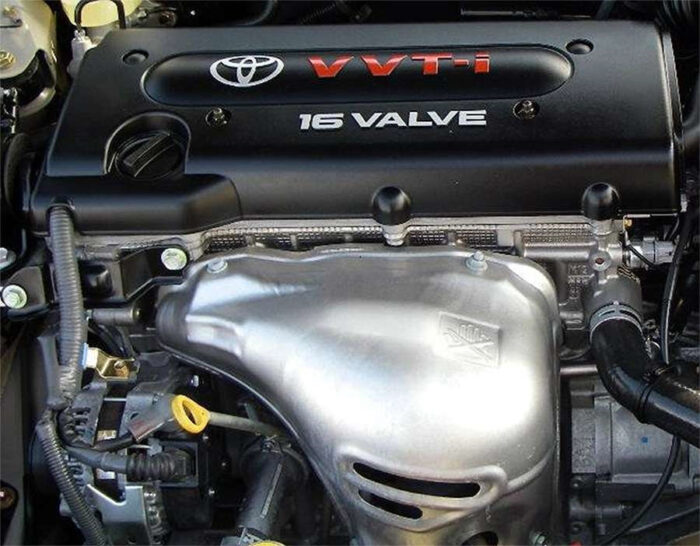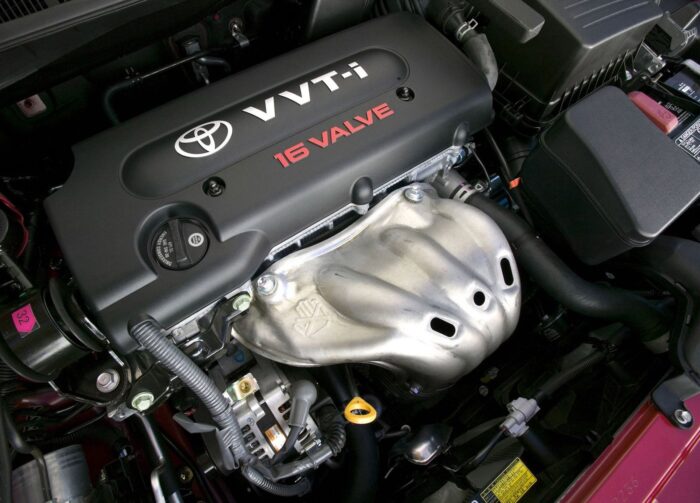The 2.4-liter Toyota 2AZ-FE engine was produced in Japan, China and the U.S. from 2000 to 2019 and was installed in the most popular models of the concern, such as the Harrier, Previa, RAV4 and Camry. Units in this series are notorious for the cylinder head bolt thread failure problem.
The AZ line also includes 1AZ-FE, 1AZ-FSE, 2AZ-FSE and 2AZ-FXE engines.
Engine specifications for Toyota 2AZ-FE 2.4 l
| Configuration | Inline |
| Number of cylinders | 4 |
| Number of valves | 16 |
| Displacement | 2362 cc |
| Cylinder diameter | 88.5 mm |
| Stroke | 96 mm |
| Power system | Injector |
| Engine power | 145 – 170 hp |
| Torque | 215 – 225 Nm |
| Compression ratio | 9.6 – 9.8 |
| Fuel type | Regular |
| Euro class | EURO 3/4 |
2AZ-FE engine dry weight is 133 kg
Basic information
This engine debuted in 2000 and was assembled at plants in Japan, China and the USA. The design was classic for the time: aluminum block with cast-iron liners and open cooling jacket, aluminum 16-valve head without hydro-compensators and timing chain drive with variable valve timing system on the intake camshaft. Like many engines larger than 2.0L, it used a balancer shaft assembly.

The 2AZ-FE engine number is located at the junction of the block and the box.
The motor has been upgraded a couple of times and besides the basic Type 00 version there are Type 03 and Type 06, which differ with minor changes in the engine electrics and environmental part. The 2006 Modification also received new bolts for the head block with a thread length of 30 mm, as the old bolts with a thread length of 24 mm often did not hold, which led to a tear in the cylinder head. Versions after 2008 have an increased compression ratio from 9.6 to 9.8 and more power.
Fuel consumption 2AZ-FE
The Toyota Camry 2007 with manual transmission as an example (l/100km):
| City | 11.6 l |
| Highway | 6.7 l |
| Combined | 8.5 l |
What cars use the Toyota 2AZ-FE
| Alphard 1 (AH10) | 2002 – 2008 |
| Alphard 2 (AH20) | 2008 – 2015 |
| Camry 5 (XV30) | 2001 – 2006 |
| Camry 6 (XV40) | 2006 – 2011 |
| Harrier 1 (XU10) | 2000 – 2003 |
| Harrier 2 (XU30) | 2003 – 2008 |
| Highlander 1 (XU20) | 2000 – 2007 |
| Ipsum 2 (XM20) | 2001 – 2009 |
| Mark X ZiO 1 (NA10) | 2007 – 2013 |
| Matrix 2 (E140) | 2009 – 2014 |
| Previa 2 (XR30) | 2000 – 2005 |
| Previa 3 (XR50) | 2006 – 2019 |
| RAV4 2 (XA20) | 2003 – 2005 |
| RAV4 3 (XA30) | 2005 – 2008 |
| Solara 1 (XV20) | 2001 – 2003 |
| Solara 2 (XV30) | 2003 – 2008 |
| xB E150 | 2007 – 2015 |
| tC AT10 | 2004 – 2010 |
| Vibe 2 | 2009 – 2010 |
Reviews on the engine 2AZ-FE
Advantages:
- Has a very wide distribution
- With proper care it is resourceful
- Affordable service and cheap spare parts
- Undemanding to fuel quality
Disadvantages:
- Problems with bolt breakage in the head
- Relatively short lifespan of timing chain
- Oil consumption is very common
- Overheats in traffic

Toyota 2AZ-FE 2.4 l Engines Maintenance
| Interval | every 10 000 km |
| Oil capacity | 5.0 l |
| Need to change | 4.3 l |
| Type of oil | 5W-20, 5W-30 |
| Timing Chain Type | Chain |
| Service life | not limited |
| In practice | 150 000 km |
| Re-adjustment | every 100 000 km |
| Air filter | 40 000 km |
| Fuel filter | 50 000 km |
| Spark plugs | 30 000 km |
| Antifreeze | 5 years or 80 000 km |

Problems & disadvantages of the engine 2AZ-FE
Breakage of cylinder-head bolts
The most notorious problem with these engines is thread breakage of the cylinder head bolts. The designers did not choose its length correctly and over time there was a gap under the cylinder head, which led to mixing of oil and antifreeze. In 2006 the threads were increased to 30mm.
Oil Compounding
The power units of the first years of production suffered from relatively moderate oil consumption, but after the renewal in 2006, it greatly increased and became a hallmark of the series. Lubricant consumption was usually caused by lagging of the lube rings.
Low timing chain life
The timing chain is driven by a thin chain, which often stretches out by 150 thousand km. The phasor regulator on the intake is a bit longer, and they are often replaced at the same time.
Overheating
These engines do not like to drive for a long time at low speed, for example (l/100km), in traffic jams. In purely city engines it is not uncommon for cylinders to ellipse up to 200,000 km.
Is the Toyota 2AZ-FE Engine Reliable?
The Toyota 2AZ-FE engine is known for being a reliable and powerful engine. While it may not be as powerful as some of its rivals, the 2AZ-FE engine has an excellent track record when it comes to long-term reliability. In this post, we’ll take a look at the 2AZ-FE engine and what makes it so reliable. We’ll also discuss how to ensure your 2AZ-FE engine can reach the highest possible miles of use.
Oil Consumption Issues
The main issue associated with the 2AZ-FE engine is oil consumption. This can be caused by a variety of issues, such as worn piston rings or valve seals. However, while oil consumption can be an annoyance, it doesn’t have any major impacts on long-term reliability provided that you are topping up your oil regularly.
High Mileage & Age May Result in Oil Leaks
Another issue that can arise with age and high mileage is oil leaks. This is usually due to worn gaskets or seals that need to be replaced. Fortunately, these repairs are relatively inexpensive and easy to do if you catch them early enough.
Basic Maintenance Equals Longer Life Span
To ensure your 2AZ-FE engine reaches 200,000+ miles of reliability, basic maintenance like timely fluid changes and oil topping up should be done regularly. Additionally, if any signs of wear are seen on any components of the engine (such as piston rings or valves), they should be replaced immediately to further prolong its life span. Some engines have even been known to last beyond 300,000 miles with proper maintenance.
Overall, the Toyota 2AZ-FE engine is considered generally reliable with average to above average remarks regarding longevity and performance capabilities. Oil consumption can sometimes become an issue but has no major impacts on long term reliability so long as you keep up with basic maintenance like timely fluid changes and oil topping up; some engines have even lasted beyond 300k miles! With regular maintenance and care of this motor unit you should expect many years (and miles) of good service from your vehicle’s powerplant!
0 Comments